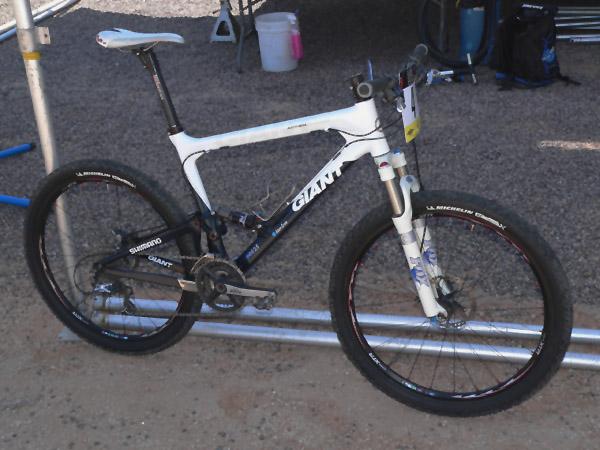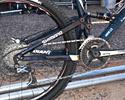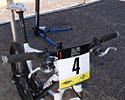
Recently on Cyclingnews.com |
Pro bikes, April 3, 2007
Adam Craig's Team Giant Anthem Advanced
Sharp-edged full-suspension for the tight-and-twistiesBy James Huang in Fountain Hills, AZ Team Giant rider Adam Craig played a key role in developing Giant's dedicated short-travel Anthem XC-racing platform two years ago, and has been heading straight down the dual-suspension path since then with virtually no looking back. At the first major MTB test of 2007 on U.S. soil here in Fountain Hills, AZ, Craig opted to use his Anthem for each stage save only for the twilight short track event that was held downtown on a mix of pavement and dirt. "I can ride a hardtail as fast in almost all situations, but it would take so much more effort," stated Craig. "If I were to put that much effort into riding a dualie, I'd end up going a teeny bit faster in a much more relaxed and much more composed manner. We're fortunate enough to have a super efficient suspension design that gives you faster rolling over all of the square-edged stuff because of the axle path and it just generally facilitates riding fast." Craig himself played a key role in the creation of his Anthem, which was formerly launched just prior to Interbike 2005. "I personally, and everyone at Giant, including Rune Hoydahl, involved in development agreed across the board that we could make a super steep, super short, aggressive race bike that would be designed to handle like a razor blade on courses like this where it's just all super turny and twisty," said Craig after his second place finish in the Stage 1 time trial. In spite of Anthem's somewhat nervous tendencies, Craig says that it's easy to calm things down a bit for when he occasionally prefers a slightly more mainstream geometry to suit a particular course. "The thing handles rad and is best designed around an 80mm fork, which still seems to be about all you need for XC racing. For me, for a course like this, you want super-quick and twitchy, even front heavy for keeping your line around corners and drifting. But then for somewhere like Mt. Snow, maybe I'd race with a 100mm fork just to slack it out for bombing through rock gardens and roots and stuff. So it gives you a lot of options." For the 2007 season, Giant provided Craig with a new carbon version, called the Anthem Advanced. Just like the aluminum original, Craig's Anthem Advanced is a razor-edged handler that rewards the attentive but leaves little room for a wandering mind on the race course. Key geometry highlights include a near-road bike steep 72° head tube angle, short chain stays, a low bottom bracket height, and compact frame dimensions, all of which are intended to produce a light and fast feel. The material change and an aluminum and titanium hardware upgrade, however, shed as much as 220g off last year's race machine. "The dimensions are the same between the Advanced and the aluminum, which is great because we spent a bunch of time figuring out dimensions and geometry and all that with the cheaper alloy version before the mold-setting began," he said. Now that that mold-setting is complete, though, the nine-time US National Champion is happy to report that the improvements associated with his new bike aren't just weight-related. "The carbon one is definitely a little bit stiffer, especially in the bottom bracket area, just because we were able to optimize the lay up of the fibers, and the head tube is a little bit stiffer as well with that boxy section similar to the Trance," he said. "So it's definitely a little stiffer, and it's just more damped. Carbon definitely rides a little better, so on courses like this it's pretty apparent, because there's real square-edged rocks that are embedded that aren't going anywhere that the suspension is helping on, but it's not the end-all for it just because it's so chattery. So it definitely dampens that, and rides smooth and good, and feels really springy. You can kind of preload the bike, both the suspension and kind of laterally; just a little bit of that flex that will work to your advantage and then kind of spring it out in the other direction. It's really easy to load and unload the bike, and it feels really nice." Giant designers also retained the aluminum Anthem's Maestro dual-link rear suspension design, but faithfully reproduced it with a lighter and more rigid carbon fiber rear end. "One of the best things about Maestro, which I always kind of wondered whether it was real or not, is just the low center of gravity of the bike," Craig added. "The shock's basically at the bottom bracket and you really notice that in that edge-to-edge. Between the steep head angle and the low center of gravity, the bike is just really quick and responsive so that's a design concept we wanted to hang on to and accentuate if possible." As already mentioned, Craig prefers to race his dual-suspension rig in nearly all situations, but still keeps a hardtail in his quiver for special occasions, or for "whenever I'm on a race course that's not that inspiring, which is not that often. Last year I think I raced courses like Madrid… World Cups basically. [The hardtail] ends up being a little more effective on those courses because it's so light and quick and no holds barred. But for anything that's on decent, reasonable trails, what you lose in the two pounds of extra weight, you gain in overall fatigue." Speaking of hardtails, Craig hinted that his title sponsor, Giant Bicycles, has not put high-end hardtails to bed just yet. "We're actually doing some hardtail development, looking at some new materials and new construction in the next few months. We're going to do some interesting stuff with that, and see what comes of it. So that'll be a good excuse to race hardtail a little bit. Maybe I'll be on it at Houffalize if it's muddy, or maybe I'll be on a dualie. It depends on what you're doing." PhotosFor a thumbnail gallery of these images, click here Images by James Huang/Cyclingnews.com
| |||||
Full specificationFrame: Giant Anthem Advanced, formulaOne Composite, size 20" Critical measurements Bottom bracket: Shimano XTR Hollowtech II FC-M970 |
Wheelset: Shimano XTR WH-M975 Bars: Race Face Next SL LR, 620mm wide Pedals: Shimano PD-M970 Total bike weight: 11.03kg (24.3lb) | ||||








